- News
- Reviews
- Bikes
- Accessories
- Accessories - misc
- Computer mounts
- Bags
- Bar ends
- Bike bags & cases
- Bottle cages
- Bottles
- Cameras
- Car racks
- Child seats
- Computers
- Glasses
- GPS units
- Helmets
- Lights - front
- Lights - rear
- Lights - sets
- Locks
- Mirrors
- Mudguards
- Racks
- Pumps & CO2 inflators
- Puncture kits
- Reflectives
- Smart watches
- Stands and racks
- Trailers
- Clothing
- Components
- Bar tape & grips
- Bottom brackets
- Brake & gear cables
- Brake & STI levers
- Brake pads & spares
- Brakes
- Cassettes & freewheels
- Chains
- Chainsets & chainrings
- Derailleurs - front
- Derailleurs - rear
- Forks
- Gear levers & shifters
- Groupsets
- Handlebars & extensions
- Headsets
- Hubs
- Inner tubes
- Pedals
- Quick releases & skewers
- Saddles
- Seatposts
- Stems
- Wheels
- Tyres
- Health, fitness and nutrition
- Tools and workshop
- Miscellaneous
- Cross country mountain bikes
- Tubeless valves
- Buyers Guides
- Features
- Forum
- Recommends
- Podcast
feature
Inside Campagnolo
For a roadie, getting invited to Campagnolo’s HQ in Vicenza, northern Italy, is a high point. It’s like getting to visit Willy Wonka’s chocolate factory. I mean, this isn’t any old bike company… this is Campagnolo. Actual Campagnolo. And we’re here. Walking around. Eyes wide. Looking at stuff… At Campagnolo.
Allow me to get all misty eyed for a minute. The first cycling jersey I ever owned had Campagnolo writ large across the front. Raleigh Campagnolo. Red wool with a yellow band around the chest. Black, felty letters. 1984, maybe. I was 14, something like that. Got it for Christmas. I loved that jersey. I still have it in the other room. I still love it. It was too big for me to start with and was soon too small but I wear it about once a year anyway, even now.
I didn’t own any Campag kit back then or for ages afterwards, but I loved the Campagnolo name. Italian. Exotic. Heritage and prestige packed into one word.
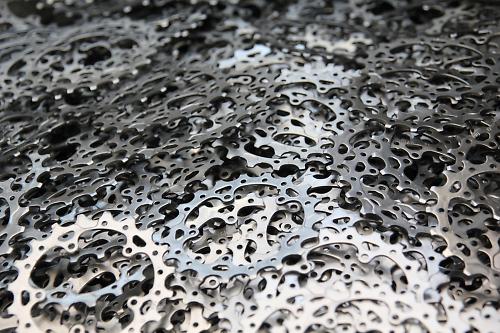
Spin forward 20-odd years... Dave and I are in Vicenza mainly to check out the new EPS electronic shifting system but when Campag’s Lerrj Piazza offered us a look around their place at the same time, well, we were in the door faster than you could say “I’ve got a golden ticket.”
And here we are. The first thing you notice is the scale of the operation. It’s large. Campagnolo employ over 700 people here. You’ve got the offices and a big factory all together on one site. Campag have got their own internal patent department tucked away in here somewhere; they’re one of only three Italian companies who have one, Lerrj tells us.
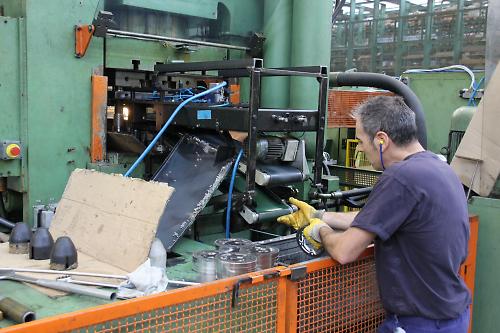
Anyone who strokes their chin knowingly and tells you that, of course, Campag make all their equipment in the Far East these days, is wrong (not that I subscribe to the notion that Europe equals good, Far East equals inferior in the first place).
Campag do own a facility in the Far East and one in Romania but the design is done here in Vicenza. Initial production is usually done here too because Campag can control it more easily on site and get everything exactly how they want it.

Then, once everything is up and running and they’re happy with the product, they’ll often shift the manufacture to one of the other facilities. The machines will frequently get shipped out too so it’s just the location of the production that changes.
The Super-Record and Record EPS systems, for example, were developed here in Vicenza. We chatted with the guy who headed up the product development, Flavio Cracco, who works here on site. It’s made here too and will be for the foreseeable future.
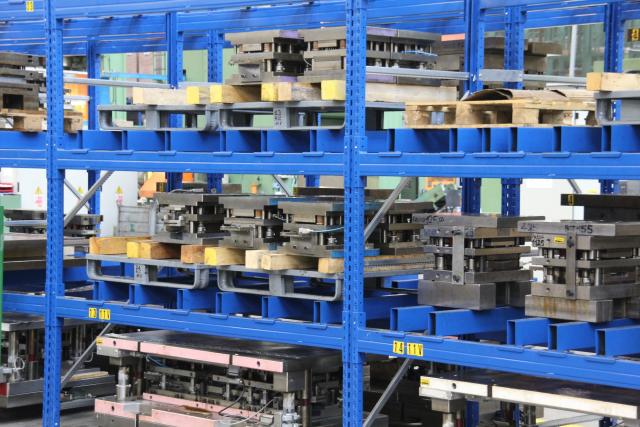
All the dies and moulds are here too, all lined up and labelled. That’s a whole lot of cycling history lined up on those shelves.
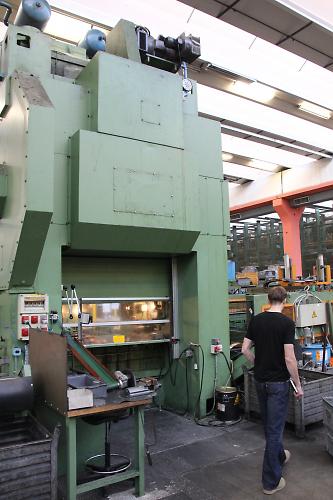
Some of these machines are huge. They’re monsters. Twenty feet tall, maybe. We stand by one that’s making chainrings, pressing them out of sheets of metal. That’s a whole lot of pressure going on in there.
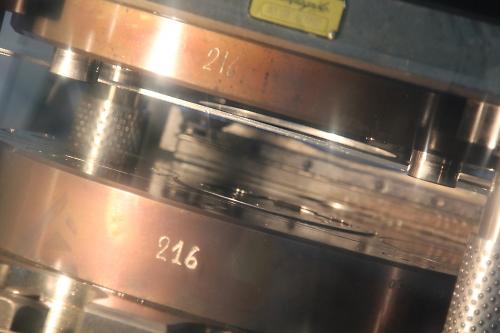
And out they pop one at a time, each of them getting a quick inspection before it moves on to the next step of the process while unused metal gets spat out the other side.
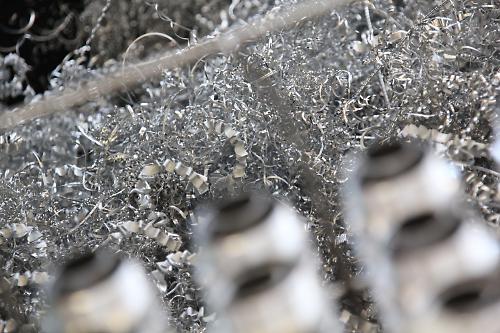
There are cranks being born, mechs, brake callipers, bottom brackets… You name it, if it’s part of a groupset, it’s being created here, every bit of it eventually destined to make a difference to a cyclist’s life somewhere in the world.
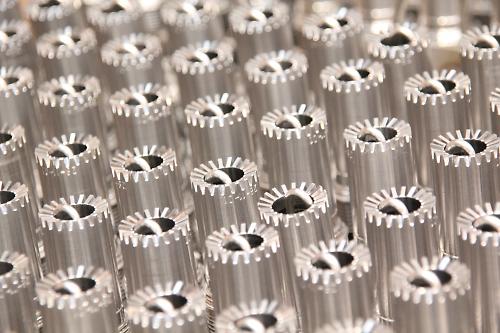
It takes a minute to work out what some of the half-formed stuff is. There are CNC machines with swarf landing in bins and the whole place smells like the metalwork classroom at school (big shout out to Mr Sanquest. Actually, I’d better shout loud; he was knocking on back in the eighties).
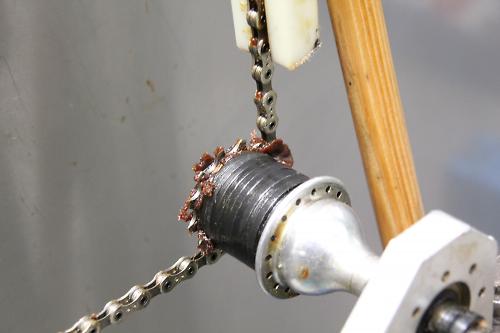
I’ve never thought about how chains are made before. It has never crossed my mind but, obviously, there has to be a machine somewhere knocking pins into every link, and here it is doing a precise job at an incredible speed, yard after yard of finished chain streaming out. That's a Campag hub that they're using as a roller in the production, by the way.
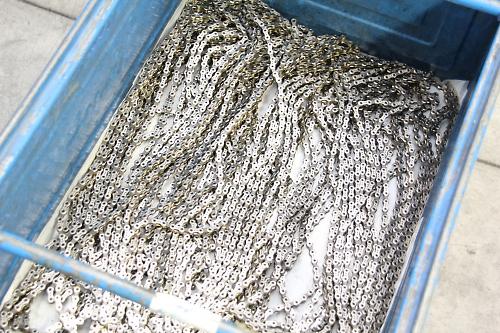
Anyway, I’ve found myself talking about the production of bicycle chains so I’d better stop myself right now and move on… There’s a room where the chainrings come in on a track in the sky – they call it the rollercoaster – and they’re loaded onto a rack for dipping in a series of chemicals to provide the protective finish.
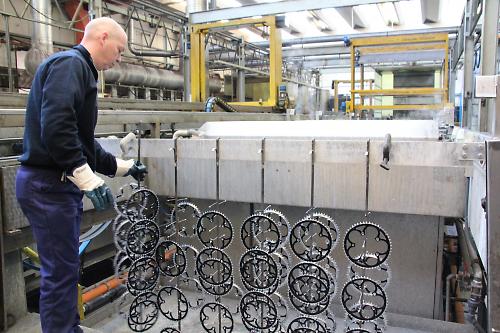
There’s a carbon fibre area we’re not allowed to photograph. There’s one new product in development that we’re definitely not allowed to photograph or even mention. And there are machines running components continuously to check each batch is up to the required standard.

One thing that’s very noticeable is that, alongside all the mechanization, people are very much involved at every stage of the process. Everything is given a once-over before moving on to the next stage and there’s loads of quality control. Campag know they’re never going to beat other brands on price – that’s not what they’re about.
No, Campagnolo are more concerned with quality; their goal is to make products that perform well and that are going to last. They want to make products with parts that can be replaced if they wear out or get broken, not ones that need to be ditched at the first sign of trouble.
“Every time a product doesn’t work as we expect, it’s a physical pain for the company,” says Lerrj. It sounds like marketing spiel but maybe it’s true.
Mat has been in cycling media since 1996, on titles including BikeRadar, Total Bike, Total Mountain Bike, What Mountain Bike and Mountain Biking UK, and he has been editor of 220 Triathlon and Cycling Plus. Mat has been road.cc technical editor for over a decade, testing bikes, fettling the latest kit, and trying out the most up-to-the-minute clothing. He has won his category in Ironman UK 70.3 and finished on the podium in both marathons he has run. Mat is a Cambridge graduate who did a post-grad in magazine journalism, and he is a winner of the Cycling Media Award for Specialist Online Writer. Now over 50, he's riding road and gravel bikes most days for fun and fitness rather than training for competitions.
Latest Comments
- chrisonabike 3 sec ago
Shurely this is just the "emotion" version of "Strava or it didn't happen"?...
- chrisonabike 9 min 13 sec ago
And other counties also have done this IIRC with total cost/ benefit - including contribution to businesses and shopping - with similar results. (I...
- chrisonabike 23 min 37 sec ago
Agree on the parking. But ... businesses will no doubt identify where all the money (in fact subsidy) is going (mass motoring) and what is seen as...
- DrG82 31 min 57 sec ago
In what way? Suspension on this type of bike or one a single leg?
- chrisonabike 34 min 26 sec ago
You can have a portable mini-carillon for not too much effort.
- froze 3 hours 49 min ago
I pray Wiggins has found peace and happiness; he was a great cyclist, no one can take that away from him. And a huge thanks to Lance Armstrong for...
- Laz 3 hours 57 min ago
geeze....but a carbon fork, huh ? they should provide a rim brake option for us oldtimers who have matured to having more disposable income than...
- lonpfrb 9 hours 36 min ago
It's easy to remove the pipe from the fasteners which are C shaped so able to hold but not trap the pipe. Filtering through traffic is then...
- wtjs 9 hours 54 min ago
What was on offer only 2 weeks ago was either 'world' for £20 or tiny areas such as 'Blackpool area' for £5 each or something. You couldn't just...
- Simon E 10 hours 17 min ago
“fastest, lightest, and most durable road tyres yet” Yeah right. "Strong, light, cheap. Pick two."





























Add new comment
20 comments
Nice article Mat. I have the original Record groupset on my 2005 Opera. I love the feel it and it's amazing it still works flawlessly today.
The best description I've heard to describe Campagnolo is, "Shimano wears out, Campagnolo wears in". Noticing the guy about who mentioned SRAM, I'd love to see more on SRAM as I've heard some abominable feedback about their quality.
Love it. I couldn't compare Campag with anything else as I've never used anything else. I do have a couple of friends who've had a go on one if my bikes, been puzzled by twin levers and after 10 mins have thought the system superior so there you go. Hardly exhaustive research but good enough for me. The 'unreliable Italian c**p versus 'soulless Japanese c**p' battle rages on.
Great article. Love the Record(?)hub as a roller on the chain machine.
Campag no1, end of! Great read and pics!
Interesting article I have loved Campag since 1966 and still ride a Nouvo Record on one of my bikes with Campag handlebar controls!!! It is a shame that Campag have to manufacture outside of Italy but I suppose that is modern day economics.
another Campag fan here - I have it on 4 road bikes. what I like about Campag kit is that it needs so little fettling in use. once it's set up correctly it keeps on working day in day out without complaint. friends who have Shimano or SRAM always seem to be fettling with their setups.
someone once told me that Shimano sell more groupset kit in a day than Campag do in a year - now I don't know if that's true or not but who cares about volume sales as a user? I'll go with quality every time.
BL - one thing I have found with Campag kit to ensure it keeps working fine is to completely strip it down once a year and give it a good degrease and clean. It will feel like brand new when you put it back together and any little annoyances seem to go. maybe a thought with your issue?? alternatively you might have a little kink somewhere in the cabling, or even some dirt in a cable outer, which is causing it to stick - perhaps strip the system down and have a good look at it, and lube any moving parts (even inside the cable outers) with something like GT80.
Just trying to count the bikes I've had over the last 30 years, got to 16, nearly all with Campag, I love it. I keep being told that Shi*maNO works best, is most reliable, lasts longest. My usual reply is 'It's not a completely rational business', i.e. even if it does work better, I'd still buy Campag. I can't say whether Sh... works better, who can? I just like Campag, the history, the character, the style.
However, just to give the Campag man a little pain, I have four groupsets at the moment, newish Athena and Chorus, and two Record, one 10 yrs old and one 5 yrs old. All the changers suffer from the same problem: the lever for rear shifting down (i.e. to a bigger rear sprocket) sticks. You'll be needing a smaller gear at the start of hill and the lever won't budge. A few tries, moving the lever back and forth as well as to the side, usually gets it going, but it can be a pain if you're in a competitive situation (not that I am any longer, but still a pain).
Does anyone else have this problem? What's going on?
In reply to BL above, with the "downshift jamming problem" ... and for general information (!)
This problem is usually caused by one of two things ...
On the thumb lever (lever 3) there is a small spring-loaded pivot that brings a driver pawl into engagement with a drive ratchet. If that pivot gets corroded (lots of salt from sweat can do it), the spring alone isn't powerful enough to correctly disengage the pawl from the drive. If that pawl is engaged, the inner lever at the front (lever 2) can't drive the lever internals round in the other direction to downshift. Solution - keep this area of the lever clean and use a drop of a low surface tension oil like ProLink Gold on that pivot from time to time.
The other problem is simpler, in a way. Bizarrely it's down to handlebar tape. In the case of the old 8, 9 and 10s units, if the tape covers the small dovetail at the base of the Ergolever where it meets the bar, the lug moulded into the hood can't engage in it. This means that the hood can creep forwards on the lever body and will occasionally snag the pawl mentioned above, keeping it engaged with the drive ring, so preventing lever 2 from rotating the mechanism. A broadly similar problem occurs on UltraShift, where there is a hold drilled in the lever body on the outside rear of the body - there is a mushroom-shaped lug on the inside of the hood that should locate in this hole. If the tape covers the hole, it can't, and a snagging problem occurs as described above.
There's just something about Campagnolo..
I have to agree. I remember when I first started to become interested in cycling a few years ago I was mystified by Campagnolo and the cult following it has. I just got my first Campy gruppo for an old vintage bike I am restoring and even the low range Campy gear is beautiful. I hope they can keep it going.
PPF. I have to agree with C@L,Last campag record groupset I had was on a racer in the 80's. having had dura ace and currently sram force on my racer,I am goin for a super record groupset soon,The quality of force is about tiagra/105,no higher.Very high wear on chains (2),chainrings,cassette and front mech,(5,000 miles so far)Very poor.(It's the first time "you get what you pay for" doesn't apply.) So it won't be long C@L before you get your campagnolo groupset!
Good article though road c.c.!
Romanian labour is cheaper, but it's close enough that they can keep their experts going back and forth to make sure quality is maintained. They're training the Romanians to be craftsmen in their own right. I don't think that's so bad. It's a nod to business sensibilities (expanding capacity, keeping costs down) while maintaining high quality fairly locally.
I bought a SRAM Force gruppo with my latest CX bike, and I regret it. It's not that SRAM is bad, but I've been riding Campagnolo exclusively for about 10 years now. I had a 9-speed Veloce gruppo working on my road bike for 6 or 7, and a 10-speed Veloce group on my other CX bike for 5 or 6. I've ridden it through the winter and snow and salt and it's only now started getting a bit too sloppy to maintain. I was blinded by the low price and weight combo of SRAM; I didn't realise I'd miss the ergonomics and finish of the Campy stuff so much.
The build quality of my new Chorus group on my road bike is so obvious and the parts are such a delight. They make me feel like a *real* cyclist, even though I know there's nothing special about them in particular. After this Force group has worn itself out, I'll ditch it for something great from Campagnolo again.
Quality products at a premium price, I am happy to pay extra for Campagnolo kit. Feeling the benefits and a happy rider ...
Not sure I fully agree with Dave.
Assuming they are increasing production shouldn't an Italian company with their countries problems be looking to create employment at home? Not necessarily Vicenza but must be a facility somewhere. I accept it may be cheaper in Romania (by how much?) but most campag owners can/will probably afford it.
"their goal is to make products that perform well and that are going to last. They want to make products with parts that can be replaced if they wear out or get broken, not ones that need to be ditched at the first sign of trouble"
Word!
Great article.
How about I, an anonymous criminal, kidnap one of you and threaten to kill you unless you tell me what that secret product is? Of course you couldn't identify me and no harm will be done to you so everyone would be happy

Great story, but Campag is about to move another large chunk of its Italian production to a second facility in Romania !
Your point being...?
Are they not just increasing their capacity? It's hard to see how they'd grow the Vicenza site, and if you have to bring a new facility online presumably it makes economic sense to do it in Romania over Italy right now.
ace story - thanks for that